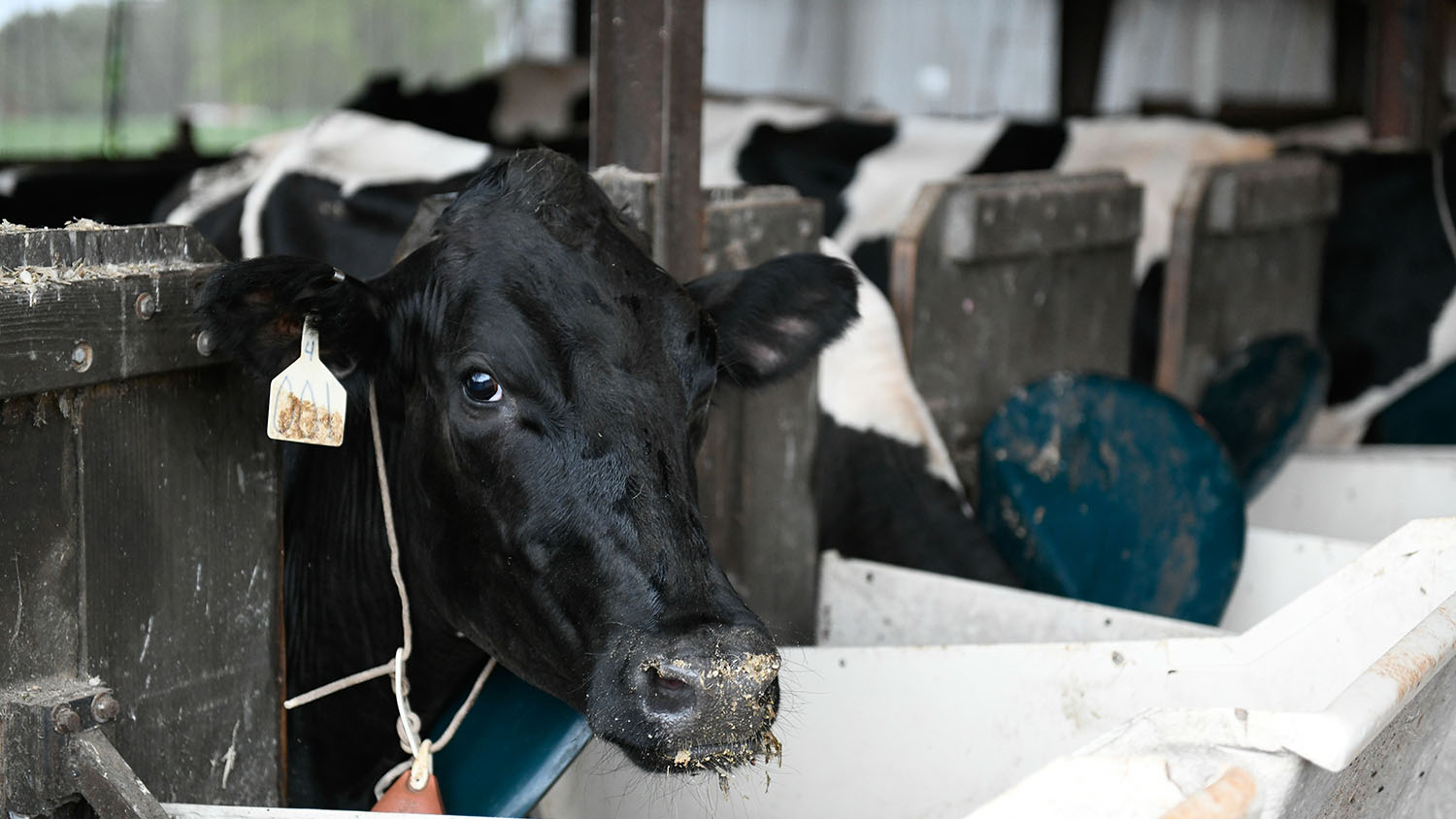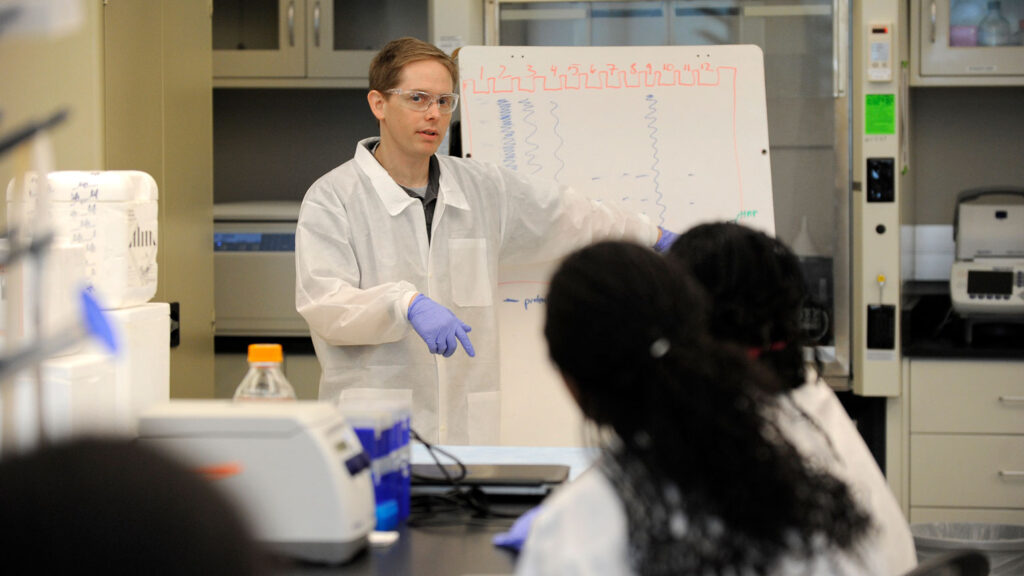What to Know About Avian Influenza in N.C. Dairy Cattle

North Carolina State University’s Matt Koci stays up to date on infectious diseases as a virologist and immunologist in the Prestage Department of Poultry Science.
Over the past week, Koci and his students have had the chance to hear from state regulatory experts who were in the midst of responding to the first-ever detection of highly pathogenic avian influenza in North Carolina dairy cattle. He had booked them as guest speakers weeks before.
The National Veterinary Services Laboratory confirmed on April 9 that highly pathogenic avian influenza had been detected in a North Carolina dairy herd. As of April 15, cases had also been documented in Texas, Kansas, Michigan, Idaho, New Mexico, Ohio and South Dakota.
Koci serves as co-director of the Animal Health and Nutrition Consortium, a partnership between industry and the Food Animal Initiative in NC State’s College of Agriculture and Life Sciences. His research, teaching and outreach work is on the interactions between pathogens and hosts and on the role that the gut immune system plays in telling friendly microorganisms from foes. He holds a master’s degree in infectious diseases and a Ph.D. in viral pathology, both from the University of Georgia.
We asked Koci to share his knowledge of viruses, particularly avian influenza.

As a virologist, you’ve said that you were surprised that avian flu was detected in dairy cattle. Why?
The short version is that everything about this is unusual, starting with finding bird flu in cows.
There are four main types of influenza: A, B, C, and D. Type D influenza is what cattle get, and we’ve only really known about D influenza for 10 to 15 years. It’s relatively new that we’ve even discovered it existed.
It’s not clear how much disease, if any, influenza D even causes in cattle. Over the last 100 years we’ve had a few reports of other influenzas being found in cattle, but they’re normally sort of brushed off, the thinking being that if Mother Nature throws enough flu around in enough places, a few cattle here and there may have gotten it, but those were probably more outliers than real cases. And even those reports were from swine and human type flus, not bird flu.
Even to think of testing cows for avian flu is a leap. The details are still sketchy as this is a rapidly evolving story, but from what I’ve heard, it was first detected in cows that were exhibiting problems with milk production, and there were dead birds nearby. But it’s not clear if there is a link there or not. And not all the positive farms have reports of dead birds nearby, so it’s hard to know exactly what’s going on now.
Do people have reason to worry about contracting avian flu from food?
That’s probably the biggest point I always try to make with folks: Whether it’s in poultry or now in cows, there is no reason to believe that any food that could be flu contaminated is a threat to the food supply.
Certainly chickens would never make it to market if they were flu positive. Now that we know to look for it in cattle, cows that were virus positive are being pulled out of herds, both to keep an infected cow from infecting others in the herd, and then also to segregate that milk so it doesn’t otherwise go into the food supply. Milk from infected cows wasn’t going to enter the food supply because it was thick and discolored.
As far as viruses go, flu is a pretty easy virus to kill. And so the milk pasteurization process, certainly the cooking process for meat and egg products, if by some weird fluke they were allowed to enter the food chain, proper food handling and proper cooking would deal with that.
Now if you’re drinking unpasteurized milk, which is illegal to sell in North Carolina, you’ve got a whole other host of potential health hazards. But with pasteurized milk and cooked meat or eggs, flu virus is not going to withstand the temperature.
Can you explain what the term “highly pathogenic avian flu” (HPAI) means? Where do the numbers used for strains of flu, like H5N1, come from?
In the letter and number naming system for flu strains such as H5N1, there are 18 different types of H’s, which is one of the surface proteins on the virus that helps the virus get into the cell. There are 11 types of the N protein that helps the virus get out of the cell. All of those combinations, H1-18 and N1-11, are possible in ducks and waterfowl, but only certain combinations are possible in humans and pigs and chickens.
Highly pathogenic avian influenza is a subset of the viruses that can infect birds. Lots of flu viruses can infect birds, but only some are actually lethal. The H5 viruses and the H7 viruses are the only ones so far that we’ve known are able to mutate and become highly pathogenic avian influenza.
For regulatory purposes, the highly pathogenic avian flu designation is based on the virus’ mortality rate in chickens. Because the virus can evolve, we do all we can to keep it from spreading, to stop it from replicating and mutating and then spreading to other places.
Should we be worried about cows transmitting bird flu to humans?
We’ve seen nothing like the past respiratory outbreaks of avian flu that spread from birds to humans, which can be fatal. With dairy cattle, there’s at least one case of a milking parlor worker in another state who contracted bird flu from cows, but there’s a major distinction there. The worker developed conjunctivitis, so they got the virus in their eye and got a really bad pink eye. That happens with a number of viruses, that if you get them in your eye, you will get pink eye.
When we send people in to help with cleaning up bird flu infections on poultry farms, they’re wearing respirator masks to make sure they don’t get virus in their lungs, out of an abundance of caution to make sure they’re not the first human case in North Carolina. They also wear eye protection so they don’t get conjunctivitis.
It is rare for people to get bird flu, the respiratory disease. When it’s happened around the world, it’s always been poultry-related and it’s always been people who’ve had what’s been described as really close contact with infected animals, such as people in Southeast Asia with backyard birds whose birds got sick.
Avian influenza can be fatal in birds. Do we know how it’s affecting dairy cattle?
So far I haven’t seen any reports of mortality amongst infected cows. It seems that they’re recovering from the infection.
By all accounts so far, there don’t seem to be mutations happening in the virus in the cows that would suggest that the virus is adapting to them in a way that would make it worse. But we’re really, really early in on this, and so we don’t know. There aren’t many places around the country, certainly for cattle, that have the containment facilities to do the kinds of experiments needed, but we’ve got folks at the federal level and state level, in multiple states, working on this.
The poultry industry and dairy industry are structured very differently. Veterinarians are trained to be large animal vets or poultry vets. And so two groups that are used to doing things specific to dairy and poultry are now working together to figure it out. It’s going to take time, but there are a lot of people working on it and we’ll get there quickly. A lot of resources are being brought to bear to get answers as fast as possible.
For the latest on highly pathogenic avian influenza (HPAI), check for updates from these state and federal agencies:
- North Carolina Department of Agriculture & Consumer Services (HPAI)
- U.S. Department of Agriculture – Animal and Plant Health Inspection Service (HPAI)
- Centers for Disease Control and Prevention (interim safety recommendations)
- Food and Drug Administration (HPAI and milk safety)
This post was originally published in College of Agriculture and Life Sciences News.


